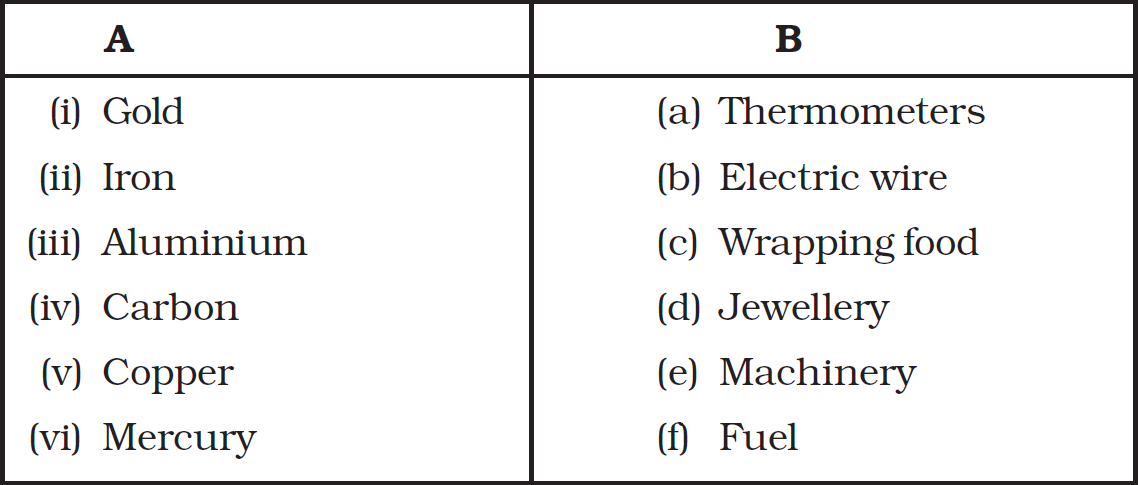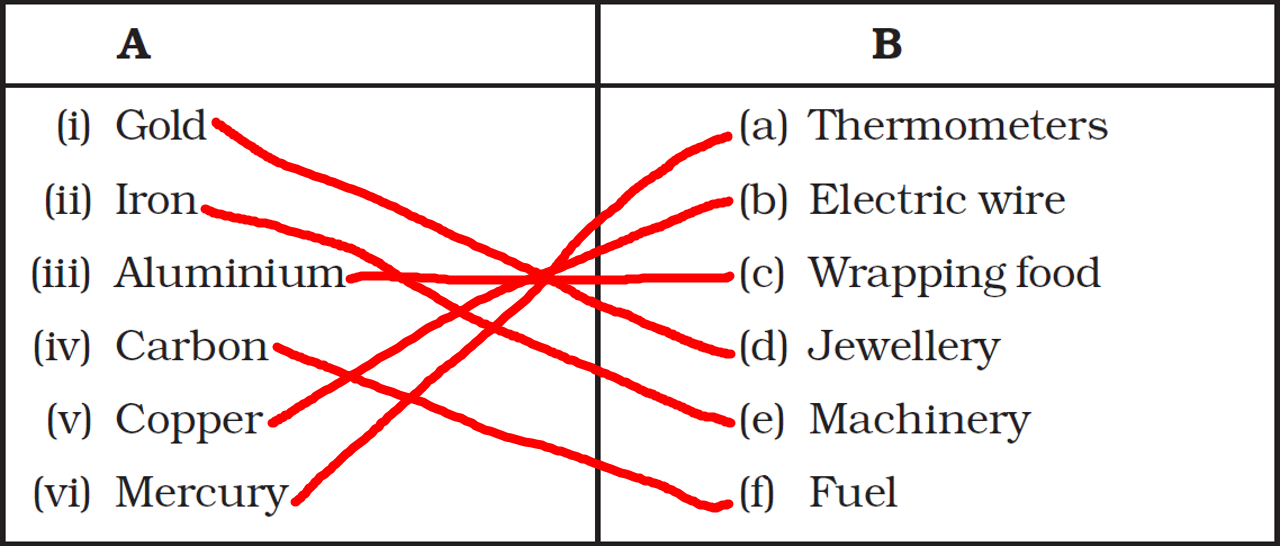Chapter 4 - Materials: Metals and Non-Metals
Question 1: Which of the following can be beaten into thin sheets?
a) Zinc
b) Phosphorus
c) Sulphur
d) Oxygen
Answer: a) Zinc
Question 2: Which of the following statements is correct?
a) All metals are ductile.
b) All non-metals are ductile.
c) Generally, metals are ductile.
d) Some non-metals are ductile.
Answer: c) Generally, metals are ductile.
Question 3: Fill in the blanks.
a) Phosphorus is a very __________________ non-metal.
b) Metals are conductors of heat and ______________.
c) Iron is ____________ reactive than copper.
d) Metals react with acids to produce _______________ gas.
Answer:
a) Phosphorus is a very reactive non-metal.
b) Metals are conductors of heat and electricity.
c) Iron is more reactive than copper.
d) Metals react with acids to produce hydrogen gas.
Question 4: Mark ‘T’ if the statement is true and ‘F’ if it is false.
a) Generally, non-metals react with acids.
b) Sodium is a very reactive metal.
c) Copper displaces zinc from zinc sulphate solution.
d) Coal can be drawn into wires.
Answer:
a) False
b) True
c) False
d) False
Question 5: Some properties are listed in the following Table. Distinguish between metals and non-metals on the basis of these properties.

Answer:

Question 6: Give reasons for the following.
a) Aluminium foils are used to wrap food items.
b) Immersion rods for heating liquids are made up of metallic substances.
c) Copper cannot displace zinc from its salt solution.
d) Sodium and potassium are stored in kerosene.
Answer:
a) Aluminium fouls are used to wrap food items because generally all metals are malleable i.e. they can be beaten into thin sheets and aluminium is a metal.
b) Immersion rids for heating liquids are made up of metallic substances because metals are good conductors of heat and electricity.
c) Copper can’t displace zinc from its salt solution because copper is less reactive than zinc.
d) Sodium and potassium are stored in kerosene because these metals vigorously react with oxygen and water.
Question 7: Can you store lemon pickle in an aluminium utensil? Explain.
Answer: No, we can’t store lemon pickle in an aluminium utensil because pickle contains lemon which is an acid and metals react with acids to form hydrogen and salts.
Question 8: Match the substances given in Column A with their uses given in Column B.

Answer:

Question 9: What happens when
a) Dilute sulphuric acid is poured on a copper plate?
b) Iron nails are placed in copper sulphate solution?
Write word equations of the reactions involved.
Answer:
a) No reaction occurs when dilute sulphuric acid is poured on a copper plate. However, when concentrated sulphuric acid is poured on a copper plate, hydrogen gas evolves along with the formation of blue coloured copper sulphate crystals. The chemical reaction for the reaction between concentrated sulphuric acid and copper:
Cu + H₂SO₄ (concentrated) → CuSO₄ + H₂
b) Iron being more reactive displaces copper from copper sulphate. In this reaction, the blue colour of copper sulphate fades and there is a deposition of copper on the iron nail. The chemical reaction for the reaction between iron and copper sulphate solution:
Fe + CuSO₄ → FeSO₄ + Cu
Question 10: Saloni took a piece of burning charcoal and collected the gas evolved in a test tube.
a) How will she find the nature of the gas?
b) Write down word equations of all the reactions taking place in this process.
Answer:
a) In a test tube containing gas, add a few drops of water. Now cover the test tube and shake well. After shaking, test the solution with litmus paper. The blue litmus paper will change its colour to red. Therefore, gas is acidic in nature.
b) Charcoal reacts with oxygen to form carbon dioxide gas.
C (Carbon from Charcoal) + O₂ (Oxygen) → CO₂ (Carbon dioxide)
Question 11: One day Reeta went to a jeweller’s shop with her mother. Her mother gave an old gold jewellery to the goldsmith to polish. Next day when they brought the jewellery back, they found that there was a slight loss in its weight. Can you suggest a reason for the loss in weight?
Answer: In order to polish the gold ornament, it is to be dipped into a liquid called aqua regia (a mixture of hydrochloric acid and nitric acid in the ratio of 3:1). On getting dissolved in the environment of aqua regia, the outer layer of gold dissolves and an inner shiny layer appears. The dissolving of the layer causes a reduction in the weight of the jewellery.
Question 12: Define
a) Conductors - Conductors are the materials/substances that allow electricity to pass through them.
b) Displacement reactions - It is a reaction in which a more reactive metal displaces less reactive metal from their compounds in aqueous solution.
c) Malleable - The property of metals by which they can be broken into thin sheets is called malleable.
d) Ductile - They property of metals by which it can be drawn into wires is called ductile.
No comments:
Post a Comment